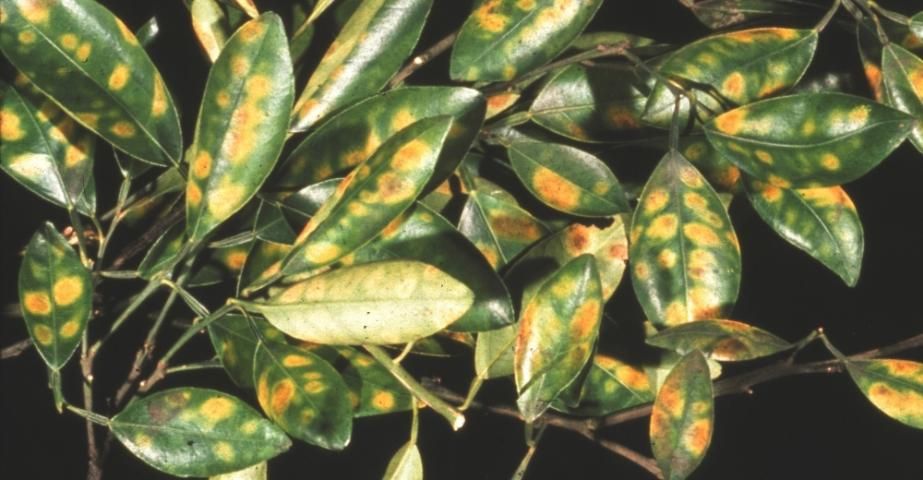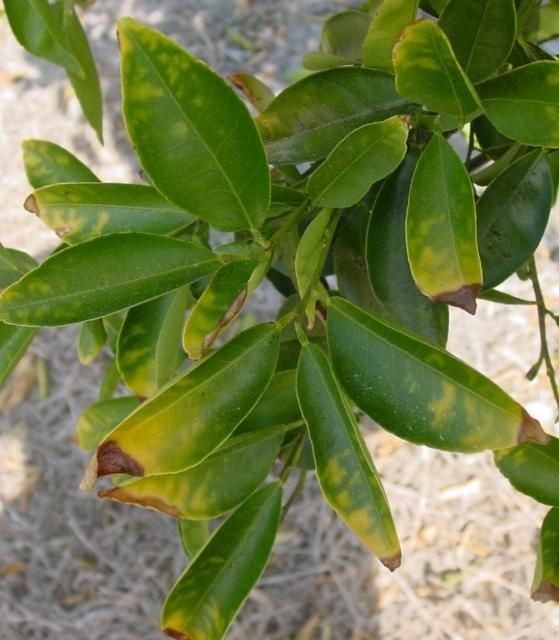This publication is part of a series about understanding nutrient requirements for citrus trees. For the rest of the series, visit https://edis.ifas.ufl.edu/topic_series_citrus_tree_nutrients.
To maintain a viable citrus industry, Florida growers must consistently and economically produce large, high-quality fruit crops year after year. Efficiently producing maximum yields of high-quality fruit is difficult without understanding soil and nutrient requirements of bearing citrus trees. Most Florida citrus is grown on soils inherently low in fertility with low cation-exchange capacity (CEC) and low water-holding capacity; thus, soils are unable to retain sufficient quantities of available plant nutrients against leaching caused by rainfall or excessive irrigation.
Seventeen elements are considered necessary for the growth of green plants:
- Carbon (C)
- Hydrogen (H)
- Oxygen (O)
- Nitrogen (N)
- Phosphorus (P)
- Potassium (K)
- Magnesium (Mg)
- Calcium (Ca)
- Sulfur (S)
- Manganese (Mn)
- Zinc (Zn)
- Iron (Fe)
- Copper (Cu)
- Boron (B)
- Chlorine (Cl)
- Molybdenum (Mo)
- Nickel (Ni)
Plants obtain C, H, and O from carbon dioxide and water. The remaining elements, which are called the "mineral nutrients," are obtained from the soil. Mineral nutrients are classified as macronutrients and micronutrients. The term "macronutrients" refers to those elements that plants require in large amounts (N, P, K, Mg, Ca, and S). The term "micronutrients" applies to plant nutrients that are essential to plants but are needed only in small amounts (Mn, Zn, Fe, Cu, B, Cl, Mo, and Ni).
When macronutrients are supplied in relatively high proportions to micronutrients for growth stimulation of newly planted citrus trees, extreme depletion of micronutrients can develop as a result of marked top growth, and micronutrient deficiencies can appear. Therefore, a balance between macronutrients and micronutrients is needed. Citrus micronutrient deficiencies are most commonly observed on previously uncultivated soils, shallow soils with high water table, extremely sandy areas, and calcareous soils.
Since mineral nutrition is a major factor in maximizing yield of high quality fruit, understanding the functions of mineral elements, diagnosing nutrient deficiencies, and providing needed fertilizers are essential. This publication describes and discusses molybdenum (Mo) and nickel (Ni) deficiencies, functions, and recommended practices to alleviate nutritional problems.
Introduction
Meeting the world's escalating food needs cannot be achieved without fertilizer input. Without fertilizer, the world would produce only about half as much food, and more forested and marginal lands would have to be put into production. Inorganic commercial fertilizer plays a critical role in the world's food security, and it is important from both yield and food-quality perspectives. Intensifying production and increasing yield on limited arable land secure a sufficient food supply, and fertilizer plays a critical role in these goals. Intensifying production is increasingly essential to meet the challenge of future food demands. However, this intensification must be done while also minimizing environmental impacts. The 4R Nutrient Stewardship Framework (i.e., right fertilizer source, right rate, right time, and right place) is therefore very important.
Functions of Molybdenum
- Assists in the formation of plant proteins
- Helps starch, amino acid, and vitamin formation
- Acts as a catalyst that aids the conversion of gaseous N to usable forms by nitrogen-fixing microorganisms
- Aids in conversion of nitrate to ammonium as a constituent of the plant enzyme nitrogenase
Functions of Nickel
- Critical constituent of the plant enzyme urease for conversion of urea to ammonia
- Chemically related to iron and cobalt
- Stimulates proline biosynthesis in plants, which is responsible for osmotic balance in plant tissues
- Foliar sprays of Ni were noted to increase yields of many plants
- Has well-defined enzymatic functions in legumes
Molybdenum Deficiency and Correction
In Florida, Mo deficiency in citrus is commonly called "yellow spot." The deficiency occurs when trees are unable to absorb sufficient Mo from an acidic soil. Deficiency symptoms appear on the leaves as large, interveinal chlorotic spots in early summer (Figure 1). As the leaves age, the yellow spots develop deposits of brown gum on the lower leaf surfaces, which may eventually turn black. In many cases, an infection of anthracnose causes the areas covered by the spots to die and drop out, leaving small holes in the leaves. When the deficiency is severe, the necrotic yellow spots enlarge and extend to the margins. Affected leaves eventually drop, and trees become almost defoliated during the winter.

Credit: Mongi Zekri, UF/IFAS
Symptoms are seldom observed on fruit except when the deficiency is severe. In severely deficient conditions, large irregular brown spots surrounded with yellow discoloration may develop on the fruit. The discoloration goes only into the peel and does not affect the albedo. Symptoms of Mo deficiency appear more common in late summer on the sunny side of the trees. Since molybdenum deficiency usually occurs in acidic soils, the most common cure is to lime the soil to a pH of 6.0–6.5, after which Mo deficiency often disappears. If liming did not fix the deficiency or if the soil pH was already around 6.5, Mo deficiency can be easily corrected with a sodium molybdate or ammonium molybdate foliar spray. For example, spraying trees showing mild yellow spot leaf symptoms with 5 oz. of sodium molybdate per acre should take care of the problem. In severe cases, spray with 10 oz./ac. If the spray is applied between summer and early fall, the leaves will re-green, and the yellow spots will disappear from the upper surface. Most of the gum will also disappear from the lower surfaces of the leaves. However, black spots consisting primarily of cork cells will remain. One spray is usually sufficient for three years or more. Soil applications are not satisfactory.
Molybdenum Sources
- Ammonium molybdate
- Sodium molybdate
Leaf analysis standard for assessing Mo status of citrus trees in 4- to 6-month-old spring-cycle leaves from non-fruiting terminals.
Nickel Deficiency
Many researchers have demonstrated that plant growth is severely impacted by Ni deficiency when urea is the sole N source. Nickel-deficient plants accumulate toxic levels of urea in leaf tips because of reduced urease activity. Nickel deficiency causes severe disruption in N metabolism, and other metabolic processes exhibited as leaf tip necrosis, marginal chlorosis of leaves, and premature leaf drop. Nickel is mobile in plants. Hence, deficiency symptoms first appear in the older leaves. Nickel deficiency has not been seen in soil-grown plants. Nickel is abundant in the soil with concentrations varying from 5 to 500 mg Ni per kg (ppm). At pH <6.5, most Ni compounds are relatively soluble. Nickel is absorbed as Ni2+ and competes with other divalent cations, such as Ca, Mg, Fe, Zn, and Mn. Nickel toxicity can be associated with biosolids application or industrial pollution, and toxicity is more common in acid soils. Application of biosolids to horticultural crops is the most common cause of Ni accumulation in the soil. Soil concentrations can range from 24,000 to 53,000 ppm Ni in soil near metal refineries or in dried biosolids, respectively. Optimum concentration in leaf dry matter of most crops ranges between 0.08–0.22 ppm.

Credit: Mongi Zekri, UF/IFAS

Credit: Mongi Zekri, UF/IFAS
Conclusion
Supplying sufficient nutrition should be a high-priority management practice for every grower. An appropriate nutrient balance using fertilizer management is necessary to achieve sufficient plant nutrition for best fruit yield and quality. If an element is below the critical level, yield production will fall—even though the other elements are kept in good supply. Balanced use of plant nutrients corrects nutrient deficiencies and toxicities; improves soil fertility; increases nutrient- and water-use efficiency; enhances crop yields and fruit quality; develops tree tolerance to pests, diseases, and other stresses; and improves environmental quality.